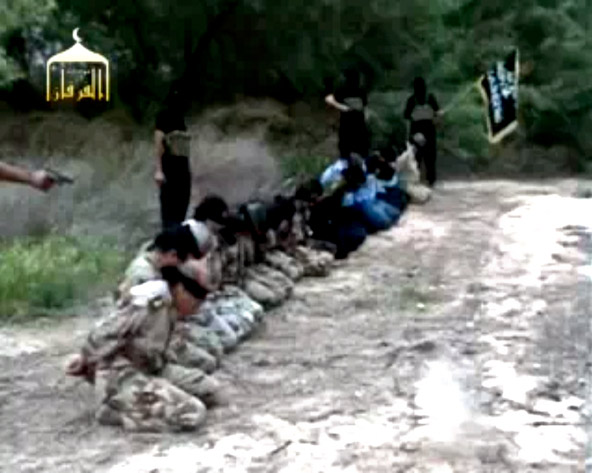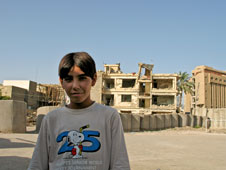
March, 2006, Iraq. A video released by Sunni insurgents allied with Al Qaeda in Iraq shows the mass execution of Shiite security officials. Mass kidnappings and executions became commonplace during the worst of the sectarian civil conflict. Sunni extremists favored mass casualty attacks on civilians using truck bombs and fuel tankers. Shiites responded with checkpoints at where drivers were interrogated and kidnapped and often executed after a videotaped confession.
Video Still: AQI
June 13, 2006 | Baghdad. It is midnight and across Jadriyah boulevard lies a dark reef of palms and blacked out houses spread out like the edge of a dead continent. The moon lies in the center of the sky, shining dully through a shroud of dust. It is the only steady light now that the power has failed. When I arrived in Baghdad on the 25th of May, I looked out these same windows over a dark space and heard the sound of a kalashnikov. It was someone emptying an entire magazine at a target at two in the morning, and then after pausing to reload, emptying a second clip for good measure. There was no answering rifle, no further information. A donkey woke and began to scream.
As the U.S. military takes a much lower profile in the capital, other forces, not just the fledgling Iraqi Army and widely-distrusted police, have come to dominate the city and its anxious population. The days of relative openness in Baghdad, which also happened to be the days of uprisings against the US occupation, are long over. The war has gone underground and militia groups are now filling a social vacuum, offering what the Iraqi government cannot, a measure of protection and harsh justice. This sea change in Iraqi society arrived with a steady increase in the flow of corpses to the Baghdad morgue, with scores found in shallow graves in fields or simply abandoned in the place of execution. The mode of killing varies with the group and the area, but most of the bodies show signs of torture. "You know the difference between the Mahdi Army and the Sunni groups?" a young filmmaker asked me recently. "The Mahdi Army bury the dead, and the Sunni militias throw them on the trash." Statistics from the ministry of health show that the average number of assassination victims reaching the health ministry over the first four months of the year, is roughly forty, a figure that does not include bomb victims, but the true numbers are higher. Not all bodies make their pilgrimage to the morgue.
Baghdad, and its five million people, has made its way steadily toward an era of mass revenge-taking, with entire neighborhood populations moving to safe areas, or areas thought to be safe. I can now count half a dozen Iraqi friends who have already fled the country and the same number who are actively making plans to leave. Everyone in Baghdad seems to be the run, or changing neighborhoods, including the manager of the storied Dulaime hotel. Sadiq al Dulaime recently moved his wife and three young children into the hotel to avoid Shia militiamen on the road to his house. "When I asked my father what I could do for him, he told me, 'What I want you to do is stay in the hotel, nothing more. That is what I want.' The road is very bad now," Dulaime has no connection to armed groups of any kind, and his family are all Baghdadis, very well known in the city. Small pockets of urban refugees have been turning up in the hotel complex, keeping quiet about their problems in the hope of not making them worse.
On a white hot day in early June, I went to the Shia neighborhood of al Shu'ala to speak to the Mahdi Army men who ran things. The building was crowned with a new sign in English which stated that it was, "The Sadreen Institute for Strategic Studies," as twenty young men wearing the uniform of black shirts and close cropped hair were piling quickly out of late model cars. The sign suggested a university of militiadom. As the entire Mahdi cell walked to the office in close formation, the men adjusted the pistols in their belts and pulled their shirts down over them. I waited at the door as the fighters were checked by the guard and were allowed into the office. One by one, as the office guard recognized the men, he gave them each a quick tap on the shoulder. A few minutes later, after the cell disappeared into the office, Hamdullah Rikabi, a Mahdi Army representative for Al Shu'ala, invited me in.
The Sadr office was packed with Iraqis asking for assistance with everything from ID cards, to death payments to information about BKC machine guns. The Mahdi Army is doing a booming trade in community relations these days, and a citizen does not have to be a Shiite or even a Muslim to ask for their help. As uncounted numbers of Shiite families flee the extreme violence to "safe" neighborhoods, the Mahdi Army is welcoming a ready- made constituency of desperate and frightened people from all over Iraq.
"We respect all journalists and their opinions," Rikabi told me warmly, before going on a conspiracy-laden rant about how American soldiers were in league with Sunni extremists. "The American soldiers were behind the Al Askari shrine bombing, directly or indirectly. If they had allowed our guards to carry weapons, we could have stopped the attack. The American soldiers must leave Iraq immediately, this is what Sayyid Moqtada says," he explained.
The thin and intense Rikabi was friendly even if his speech was pre-programmed, then went on to say that Mahdi Army soldiers were helping poor people, as I could see, and did not even carry weapons, a funny and obvious falsehood, since nearly two dozen armed men had just entered the building. It is true that the militiamen being more discreet about their weapons, but it if the past is any guide, the heavier stuff is cached close at hand. In Najaf, during the siege in 2004, the Mahdi Army leadership used a nearby religious school as an armory, and on the day the fighting ended, when Ayatollah Ali al Sistani's pilgrims flooded the city, the militia quietly disappeared with its entire stock of weapons. Najaf was a demonstration of faith and a shattering military defeat for the young militia, but those awkward adolescent days are gone, and Moqtada Sadr's followers are more disciplined and have more support than they did in the violent summer of 2004. A trace of the old days remains, and I could hear an almost plaintive note in Rikabi's accusation of U.S. complicity in the attack on the holy al Askari shrine. The Mahdi militia has good reason to want the immediate departure of US forces, since they are the only power in Iraq they fear and cannot influence.
This series was originally published in Salon.com, edited by Gary Kamiya.
 LEAD IMAGE: 6 June, 2006, Baghdad, Iraq. A young Shiite boy, Hassan, stands in front of the bombed complex at the Hamra hotel, in Karrada. Hassan's father shattered his leg when the roof collapsed and was no longer able to provide for his family. They now survive on what Hassan can earn doing odd jobs. A few months earlier, Al Qaeda in Iraq used two massive truck bombs to try to breach the perimeter of the hotel where foreign media was staying.
LEAD IMAGE: 6 June, 2006, Baghdad, Iraq. A young Shiite boy, Hassan, stands in front of the bombed complex at the Hamra hotel, in Karrada. Hassan's father shattered his leg when the roof collapsed and was no longer able to provide for his family. They now survive on what Hassan can earn doing odd jobs. A few months earlier, Al Qaeda in Iraq used two massive truck bombs to try to breach the perimeter of the hotel where foreign media was staying.Photo: Phillip Robertson
© Phillip Robertson, 2009-2014.
